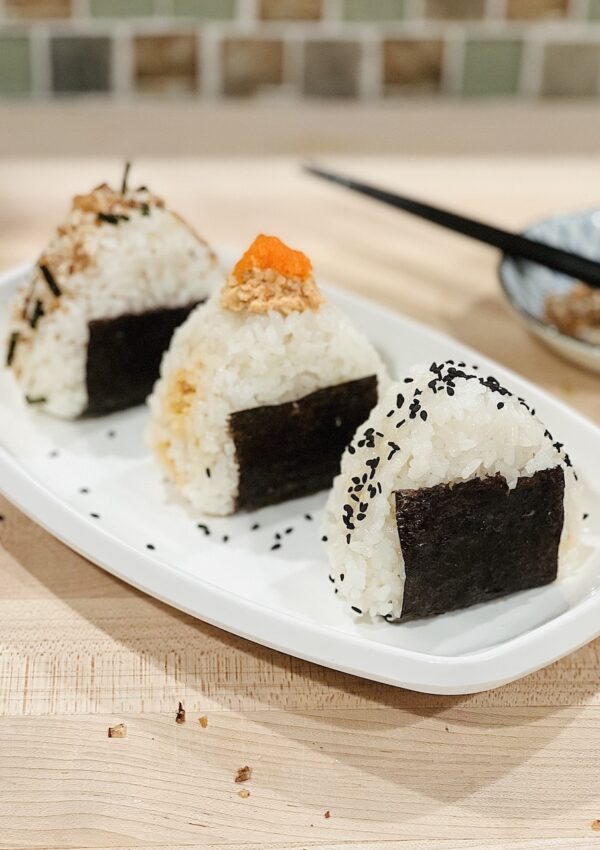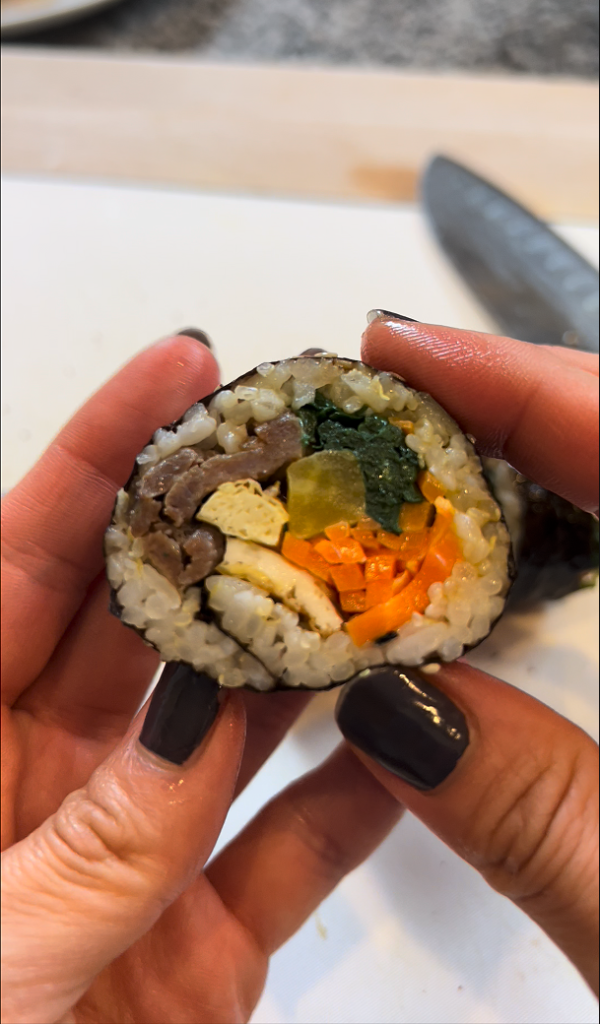
Korean Kimbap is a classic and quintessential Korean food that can be enjoyed at time of day. My classic bulgogi kimbap recipe is packed with delicious beef and filled with tons of vegetables, making it a well balanced meal or snack that is loved by adults and kids alike. It’s customizable and portable so you can eat it on-to-go or pack it to enjoy on a picnic or park bench. If you haven’t tried it yet, here is your chance!
What is kimbap?
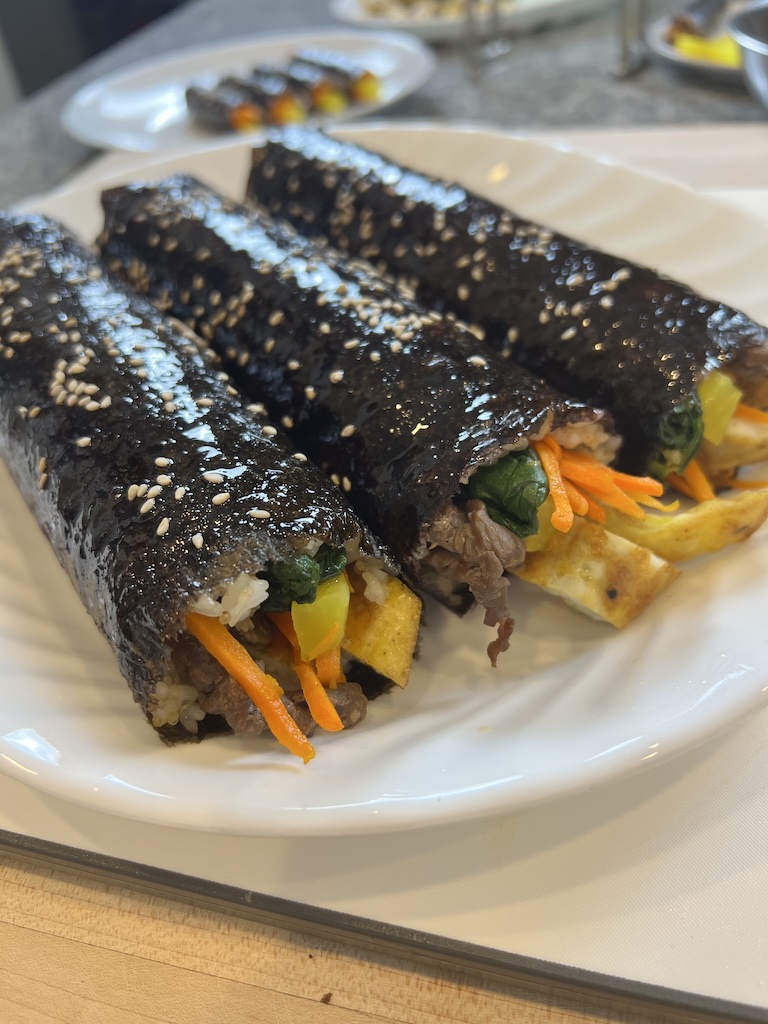
Korean Kimbap, also known as Korean seaweed rice rolls, is a classic dish rooted in Korean tradition that has recently soared in popularity. You may have seen a frozen version at Trader Joe’s or your local Asian supermarket, as well as countless videos online of people trying it for the first time. It’s become so trendy and popular that stores have reported selling out of it. While lately you can find it sold frozen to be heated in the microwave, traditionally kimbap is best enjoyed the same day it is made at room temperature.
How to eat kimbap
Kimbap cannot be easily labeled or put into a box. It can be enjoyed as a meal, snack, a lunchbox item, or a portable on-the-go quick bite. Whether you’re heading to work, school, or a picnic, kimbap’s compact form makes it an ideal choice for any occasion.
When ordering at a Korean restaurant, you can enjoy kimbap as an appetizer, a side dish, or one of many entrees. My favorite pairings for kimbap include tteokbokki (Spicy Korean Rice Cakes) and a bowl of hot soup. I love to dip my kimbap in the spicy tteokbokki sauce – highly recommend you try it this way!
Ingredients for kimbap
My classic kimbap recipe features traditional elements like beef bulgogi, spinach, carrots, and egg. However, you can customize kimbap with a variety of protein and vegetable fillings. Some popular kimbap fillings include spicy tuna, fish cakes, marinated burdock root, etc.
Bulgogi Beef
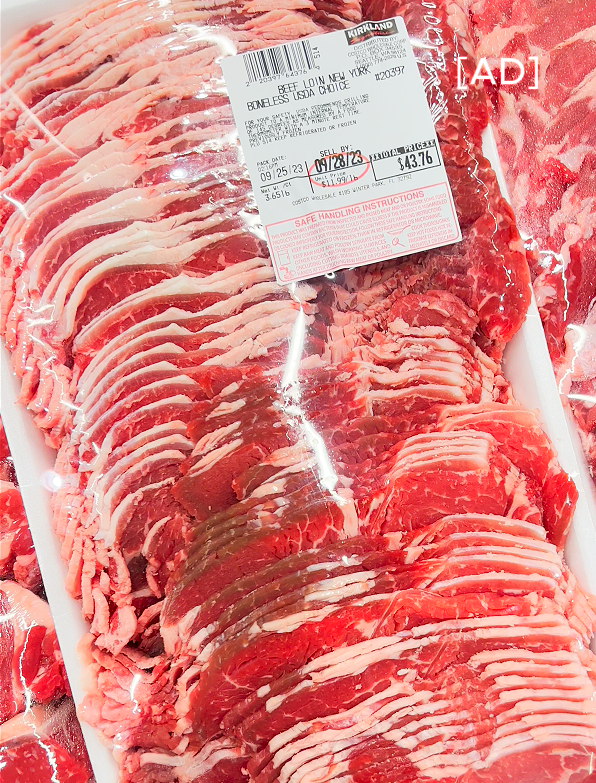
Use store bought marinated beef bulgogi if you can find it. It will cut down on time and save you a few steps. For this recipe, I’m using thinly sliced beef loin which I purchased at Costco. The marinade I am using is a shortcut bulgogi marinade and includes a short and simple list of ingredients: soy sauce, sugar, rice wine vinegar, garlic, and black pepper.
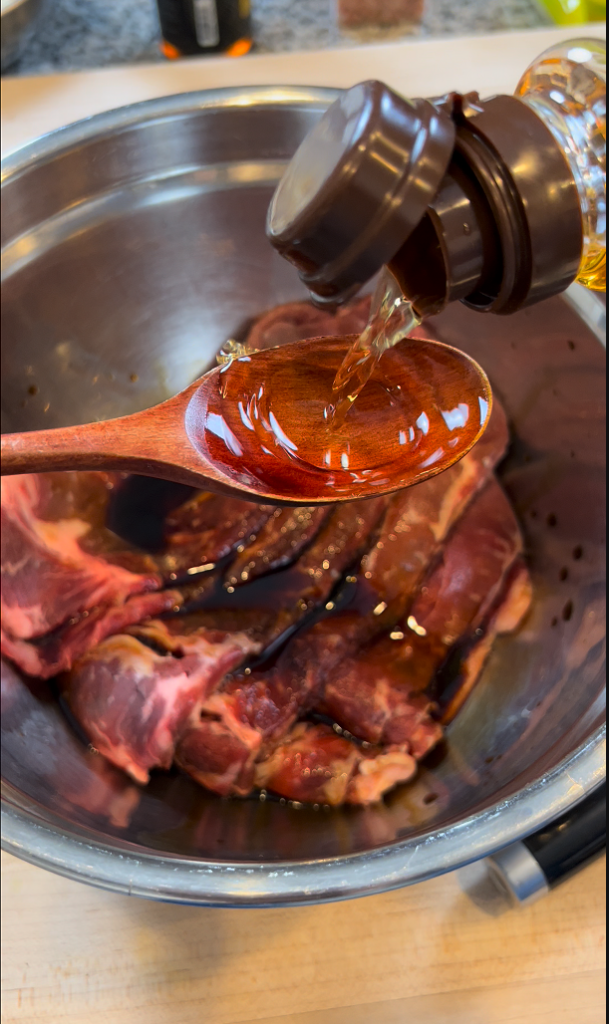
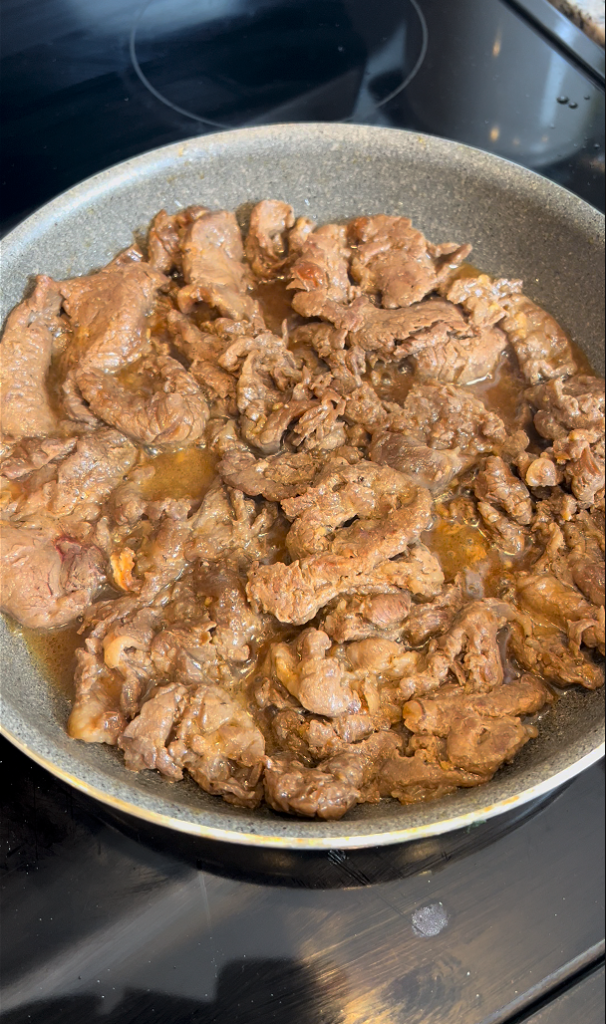
Carrots
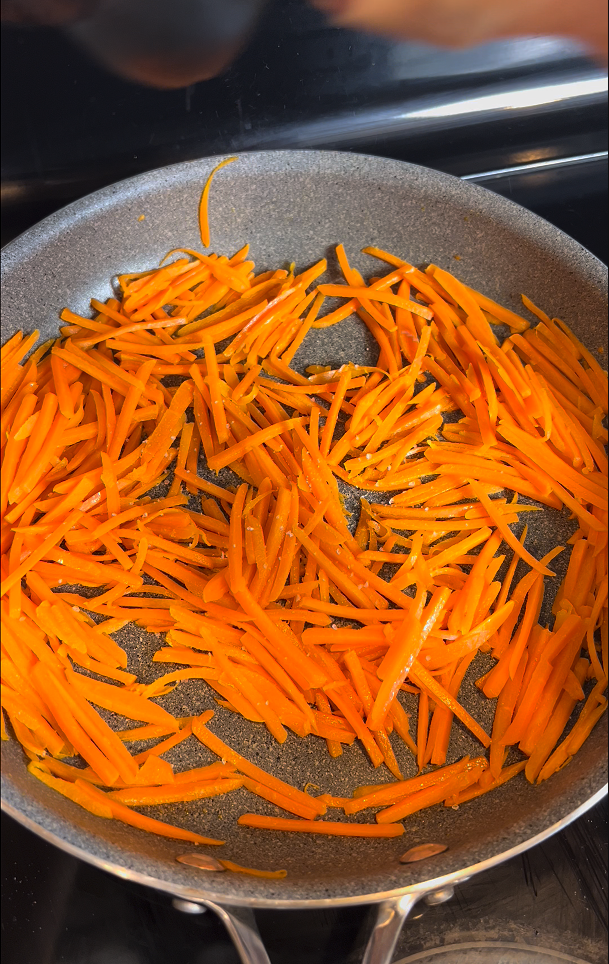
Simply saute the carrots in a little oil then season at the end with salt and sesame oil. Because the carrots have been chopped into matchstick pieces, it will only take a few minutes for them to cook and soften.
Spinach
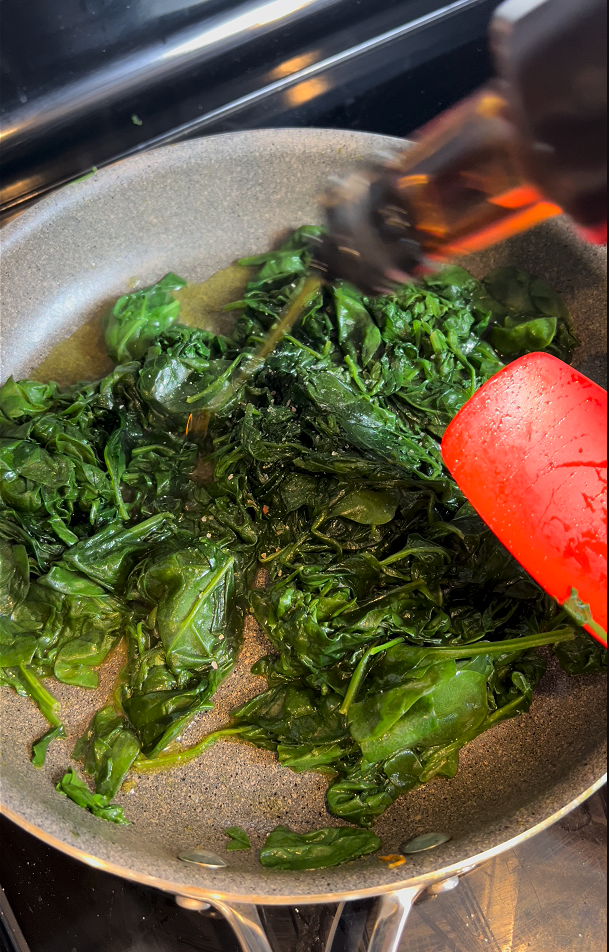
Traditionally spinach leaves are boiled then dunked into an ice bath before getting seasoned. To save time, I am using baby spinach which I get from Costco and store in my freezer. The spinach takes about a minute to wilt and cook on the stovetop. Simply garnish with a clove of minced garlic, salt, and sesame oil.
Egg
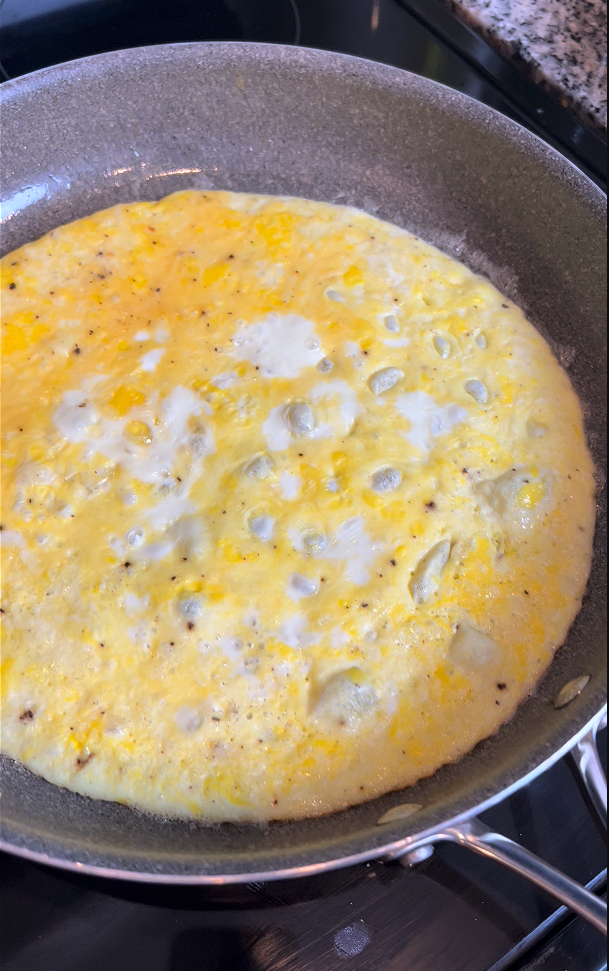

Evenly pour the whisked eggs into a pan that has been coated with oil. Once the eggs are cooked enough to flip, cook the other side then let cool on a cutting board. Once the eggs are cooled enough to handle, slice into strips.
Korean yellow pickled radish
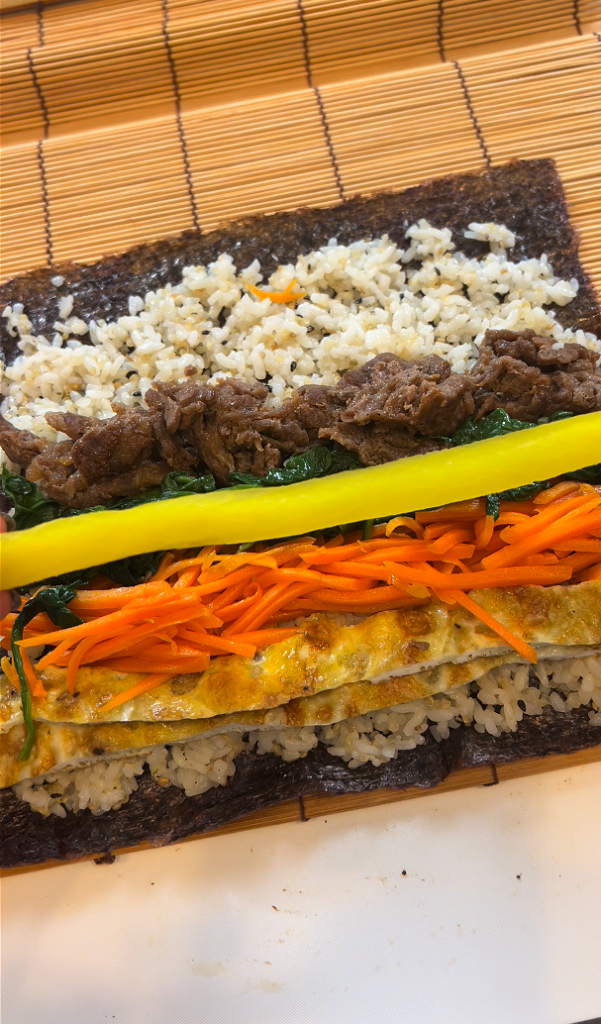
The pickled radish, also known as “dam-muji,” can be found pre-sliced at the Asian supermarket. They are sweet, tangy, and offers a very satisfying crunch to the kimbap. If you cannot find them pre-sliced, simply slice into 1/4″ strips before assembling the kimbap.
How to make Korean kimbap
For kimbap newbies, the art of rolling might seem intimidating at first. Fear not! With a bit of practice, you’ll soon find yourself rolling like a pro. The key is to prepare all your fillings and have everything laid out on a platter before assembling the kimbap. I highly recommended that you use a bamboo rolling mat. You can easily find them at Asian supermarkets or storefronts like Amazon.
Step 1: Prep and lay out the ingredients
Preparation is key for this recipe. Lay out all the fillings before assembling your kimbap on a large platter or in individual bowls/plates. This way you can easily grab what you need for your kimbap as you roll.
Step 2: Assemble the kimbap

Lay a sheet of nori on the bamboo mat then evenly spread about 3/4 cup of cooked rice, leaving about 1/2 inch at the top of the nori uncovered. Then layer on the beef, egg, carrots, spinach, and pickled yellow radish.
Use both hands to carefully fold over the edge of the mat until it touches the edge of the fillings. Gently roll the kimbap while pulling the mat upward to ensure it doesn’t get rolled into the kimbap. When you reach the edge, add a few grains of rice and smear so it so that it acts like a glue to seal the end of the kimbap.
Continue until all the rice and fillings have been used up.
Step 3: The finishing touches

Brush toasted sesame oil over the rolled kimbaps and garnish with sesame seeds. Use a sharp knife to slice the kimbap into 1/4″ coins.
*Pro-tip: Dip your knife into water frequently to prevent bits of rice from sticking to it as you slice.
Kimbap (Korean Seaweed Rice Rolls)
Equipment
- 1 Bamboo kimbap rolling mat You can find this at your local Asian supermarket or on Amazon
Ingredients
Seasoned rice
- 4 cups short grain rice cooked
- 1/2 tsp sugar
- 1/2 tsp salt
- 1 tbsp toasted sesame oil
Marinated beef
- 1 lb thinly sliced beef
- 1/4 cup soy sauce
- 2 tbsp rice wine vinegar
- 3 tbsp sugar or sweetener of choice
- 1 tbsp minced garlic
- 1/8 tsp black pepper
Cooked carrots
- 1 carrot, chopped into matchsticks
- 1 tsp toasted sesame oil
- salt to taste
Cooked spinach
- 1/3 lb baby spinach
- 1 tsp toasted sesame oil
- 1 garlic clove, minced
- salt to taste
Egg strips
- 4 eggs
Other ingredients
- 6 sheets roasted nori
- 6 strips Korean yellow pickled radish
- 3 tbsp additional toasted sesame oil to brush on rolled kimbap
- 1 tbsp toasted sesame seeds to garnish
- 2 tbsp cooking oil
Instructions
- Cook rice according to package instructions and season with salt, sugar, and sesame oil
- Add sliced beef to a bowl and add remaining ingredients for marinade. Mix thoroughly to ensure beef is evenly coated with marinade and set aside.
Cook the fillings
- Whisks eggs in a small bowl and cook in a medium pan coated with oil. Ensure eggs are spread out over entire surface of the pan. Flip and cook on the other side then carefully transfer to a cutting board. Once cooled, fold the omelette and cut into 1/2" strips. Set aside onto a platter.
- Add oil to the pan and cook the chopped carrots for about 4-5 minutes until softened. Season with salt and sesame oil and set aside on the platter.
- Do the same thing with the baby spinach. Once spinach has wilted and cooked, season with garlic, salt, and sesame oil. Set aside on platter.
- Cook the marinated beef until the meat is fully cooked and no longer red. Set aside.
Assembling the kimbap
- Lay a sheet of nori on the bamboo mat then evenly spread about 3/4 cup of cooked rice, leaving about 1/2 inch at the top of the nori uncovered. Then layer on the beef, egg, carrots, spinach, and pickled yellow radish (*optional).
- Use both hands to carefully fold over the edge of the mat until it touches the edge of the fillings. Gently roll the kimbap while pulling the mat upward to ensure it doesn't get rolled into the kimbap. When you reach the edge, add a few grains of rice and smear so it so that it acts like a glue to seal the end of the kimbap.
- Continue until all the rice and fillings have been used up. Brush toasted sesame oil over the rolled kimbaps and garnish with sesame seeds. Use a sharp knife to slice the kimbap into 1/4" coins. *Dip your knife into water frequently to prevent bits of rice from sticking to it as you slice.
- Serve at room temperature.

